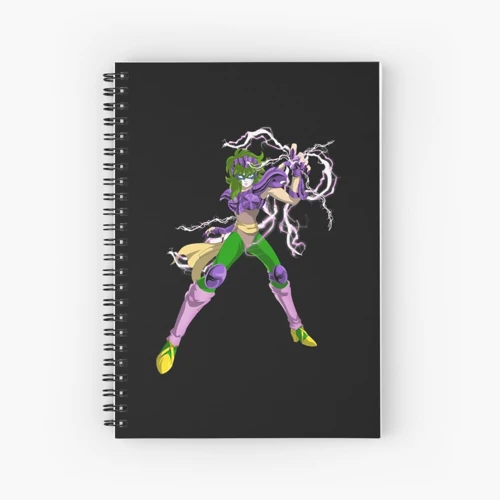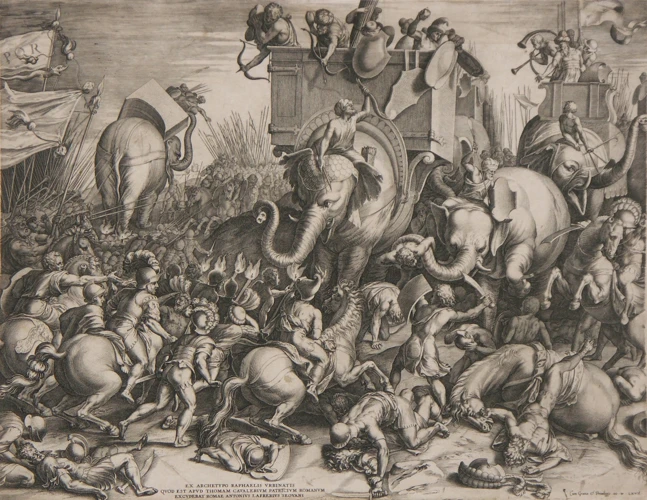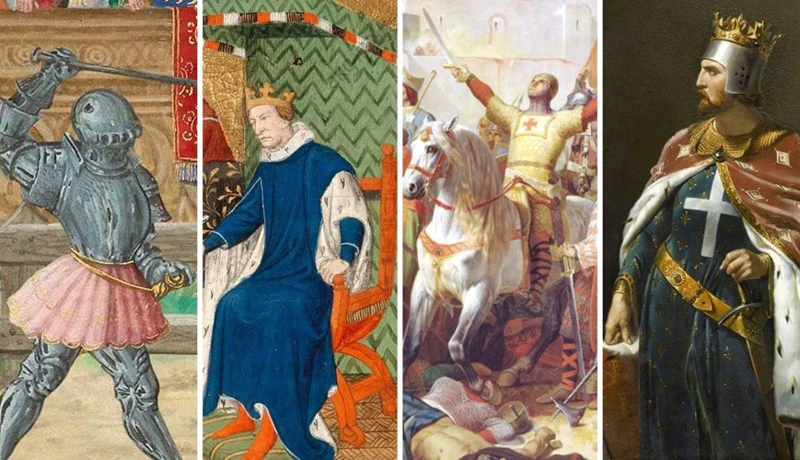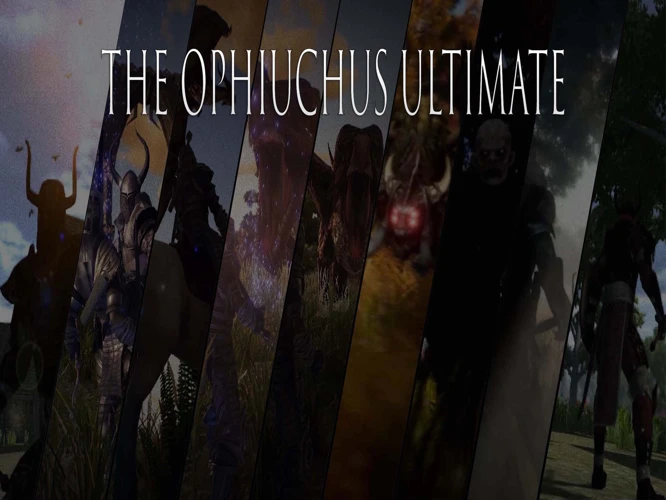The world of medieval knights is shrouded in mystery and intrigue, painted with tales of honor, chivalry, and epic battles. Stepping back in time to the Middle Ages, one cannot help but be captivated by these noble warriors who epitomized bravery and gallantry. In this article, we will delve into the rise of knights, exploring their origins and the rigorous training they underwent. We will also explore the code of chivalry that governed their actions and shaped their character. Additionally, we will examine the tactics and weapons employed in medieval warfare, including castle sieges and battles on horseback. Lastly, we will uncover the legends of renowned knights such as King Arthur and the Knights of the Round Table, Sir Lancelot, and Joan of Arc. Join us on this journey as we uncover the legacy of the medieval knights and their enduring impact on society, literature, and popular culture.
Contents
- The Rise of Knights
- Medieval Warfare Tactics
- Renowned Knights
- Legacy of the Knights
- Conclusion
-
Frequently Asked Questions
- 1. How did one become a knight in the Middle Ages?
- 2. What was the purpose of knighthood?
- 3. What was the role of a knight in medieval society?
- 4. Were knights always on horseback?
- 5. Were all knights wealthy?
- 6. Did all knights participate in battles and wars?
- 7. Were women ever knighted?
- 8. Were knights the only warriors in medieval times?
- 9. Were knights involved in any form of training or tournaments?
- 10. How did the decline of knights occur?
- References
-
Frequently Asked Questions
- FAQs about Medieval Knights
- What role did knights play in medieval society?
- Were all knights born into nobility?
- Did knights receive any formal training?
- What was the code of chivalry that knights followed?
- How did knights prepare for battle?
- What type of armor did knights wear?
- What weapons did knights typically use?
- Were knights involved in castle sieges?
- Who were some famous knights of medieval times?
- How did the institution of knighthood influence literature and pop culture?
- References
- Read More
The Rise of Knights

The rise of knights in the Middle Ages marked a significant shift in the dynamics of warfare and society as a whole. This period witnessed the birth of knighthood, a social status that combined military skill, nobility, and a commitment to the code of chivalry. Knights were typically born into noble families, where they began their path to knighthood at an early age. The process of becoming a knight involved rigorous training and education, often starting as young boys serving as pages in the households of noble lords. These pages would learn basic skills such as horsemanship, weaponry, and the art of combat from experienced knights and warriors. As they grew older, they would progress to becoming squires, serving under knights and assisting them in battles and tournaments. This stage provided them with practical experience and a deeper understanding of the duties and responsibilities that came with knighthood. The final step in the journey to becoming a knight was the dubbing ceremony, where a knight would be knighted by another knight or a noble figure of high authority. This ceremony often included a symbolic tap on the shoulders with a sword, signifying the official status of knighthood. Once dubbed, the knight would swear an oath to uphold the code of chivalry, a set of moral and ethical guidelines that governed their behavior both on and off the battlefield. This code emphasized virtues such as honor, loyalty, courage, and fairness. Knights were expected to protect the weak, champion justice, and demonstrate exemplary conduct in all aspects of life. The rise of knights brought forth a new class of warriors, who not only showcased their military prowess but also subscribed to a noble code of conduct, setting them apart from other soldiers of the time.
1. Birth of Knighthood
The birth of knighthood can be traced back to the early Middle Ages, a time when the feudal system was firmly established and society was divided into distinct social classes. The concept of knighthood originated from the need for warriors who could protect and defend their lords and estates. In the tumultuous era of constant warfare and invasions, lords sought individuals with both martial skill and loyalty to serve as their personal champions. As a result, the role of the knight emerged, combining the qualities of a warrior, a nobleman, and a guardian. Initially, knighthood was not hereditary but rather earned through merit and service. Commoners who possessed exceptional skill in combat and demonstrated unwavering loyalty to their lord were bestowed with the honor of knighthood. However, as time passed, the prestigious nature of knighthood led to its association with the nobility. The birth of knighthood marked a transformation in the social fabric of medieval society, shaping the ideals and values that would define the knights and their code of chivalry. This new class of warriors would go on to play a crucial role in the medieval world, embodying the virtues and principles of honor, courage, and loyalty that still resonate in popular culture today.
2. Training and Education
Training and education were pivotal in shaping the aspiring knights of the Middle Ages, preparing them for the rigors of warfare and instilling the values of chivalry. From a young age, potential knights would begin their education as pages, serving in the households of noble lords. This phase served as an introduction to the world of knighthood and provided basic training in skills such as horsemanship, weaponry, and etiquette. Pages would learn to ride horses, care for their equipment, and practice with weapons under the guidance of experienced knights or their squires. They were also taught courtly manners, music, and even basic literacy, making them well-rounded individuals. As pages grew older and more proficient, they would progress to become squires, where they would gain practical experience in combat. Squires would accompany knights into battle, assisting them with armor, weapons, and horse maintenance. They would observe the art of warfare, participating in training exercises and acquiring essential combat skills. The role of a squire also involved serving their knight master in various capacities, attending to their needs and learning from their experience. This mentorship allowed squires to develop not only their martial skills but also their understanding of chivalry and the responsibilities that came with knighthood. The final step in training and education was the dubbing ceremony, where a squire would be knighted by a knight or a noble figure. This transformative moment marked the completion of their formal training and their entry into the ranks of knights. It was a culmination of years of preparation, shaping them into skilled warriors and upholders of chivalric ideals. The training and education of knights were crucial in not only honing their military prowess but also nurturing their character and sense of honor. It prepared them for the challenges of the medieval battlefield and laid the foundation for their adherence to the code of chivalry.
3. Code of Chivalry
The Code of Chivalry was the guiding moral and ethical framework that knights adhered to in the Middle Ages. This code, deeply rooted in the virtues of honor, loyalty, and courage, played a significant role in shaping the behavior and actions of knights both on and off the battlefield. The code emphasized the importance of protecting the weak and defenseless, treating others with respect and courtesy, and championing justice and fairness. Knights were expected to be brave in the face of danger, demonstrating unwavering courage in their missions and battles. They were also required to be loyal to their lords, serving them faithfully and defending their honor. The code dictated that knights should be humble and modest, eschewing arrogance and self-importance. They were to be truthful and honest in their dealings, upholding their word and maintaining their integrity. The virtues of generosity and hospitality were also valued, with knights being expected to be kind and generous to those in need. The code further demanded that knights exhibit courtesy and respect towards women, treating them with dignity and protecting their honor. It also emphasized the importance of religious devotion, with knights being expected to uphold Christian values and maintain a strong faith. While the code of chivalry was an ideal to strive for, it is important to note that not all knights lived up to these ideals. Nevertheless, the code of chivalry set a standard of behavior that knights aspired to uphold, and it became an enduring symbol of knightly virtue.
Medieval Warfare Tactics

Medieval warfare tactics were shaped by the advancements in armor and weaponry, as well as the strategic considerations of castle sieges and battles on horseback. Armor played a vital role in protecting knights during combat. They wore suits of plate armor, made up of interlocking metal plates, providing maximum protection while allowing flexibility. The armor included a helmet, breastplate, gauntlets, and greaves to shield the limbs. Knights also wielded a variety of weapons, including swords, maces, axes, and lances. These weapons were designed for close combat and could inflict devastating blows upon their opponents. Castle sieges were a common feature of medieval warfare. Sieges involved surrounding and isolating a castle or fortress to cut off supplies and force surrender. Siege engines such as trebuchets and battering rams were used to breach castle walls, while archers provided cover fire. Inside the castle, defenders utilized defensive measures such as pouring boiling oil or launching projectiles from the ramparts to repel attackers. Battles on horseback, known as jousting, were a popular form of combat and entertainment. Knights would charge at each other with lances, aiming to dismantle or unhorse their opponents. Jousting required exceptional horsemanship and precise timing, making it a prominent display of skill and bravery. These tactics combined brute force, strategic planning, and individual prowess to win battles on the medieval battlefield. The evolution of warfare tactics during this period laid the foundation for future military strategies and played a crucial role in shaping the outcome of conflicts throughout history.
1. Armor and Weapons
When it comes to medieval warfare, the armor and weapons of knights played a crucial role in their effectiveness on the battlefield. Knights were heavily armored, utilizing various types of protective gear to shield themselves from their enemies. The most iconic piece of armor worn by knights was the suit of plate armor, also known as plate mail or full plate. This armor consisted of interlocking metal plates that covered the knight’s entire body, providing exceptional protection. The suit of plate armor was made up of different components, including a helmet, cuirass (chest plate), pauldrons (shoulder plates), gauntlets (hand armor), greaves (leg armor), and sabatons (foot armor). Each piece was designed to protect a specific part of the body while allowing the knight to maintain flexibility and mobility in combat. The armor was usually made from steel and could be quite heavy, weighing anywhere from 45 to 90 pounds.
In addition to their armor, knights wielded an assortment of weapons that were specifically designed for use in close combat. One of the most iconic weapons used by knights was the longsword. This versatile weapon had a double-edged blade and a handle long enough to be wielded with two hands. The longsword was effective for both slashing and thrusting maneuvers, allowing knights to engage in a variety of fighting techniques. Another commonly used weapon was the lance, a long spear-like weapon used by knights on horseback. The lance enabled knights to deliver powerful charges against their opponents, often with devastating results. The knight’s arsenal also included weapons such as swords, maces, and battle-axes, each with its own advantages and specific uses in combat.
It is important to note that the armor and weapons of knights were not accessible to everyone. The cost of acquiring and maintaining such equipment was substantial, making knighthood a privilege reserved for the wealthy nobility. This distinction further emphasized the elite status and societal importance of knights during the medieval period. The armor and weapons of knights showcased their impressive military capabilities and added to their aura of strength and authority on the battlefield. They were true exemplifications of the warrior ideal that dominated the Middle Ages.
2. Castle Sieges
Castle sieges were a prominent feature of medieval warfare, as castles provided strategic advantages that made them difficult to conquer. When faced with the challenge of capturing a fortified castle, knights employed various tactics and siege weapons to overcome the defenses. One of the commonly used tactics was the construction of siege towers, which were large wooden structures mounted on wheels. These towers would be rolled towards the castle walls, providing a vantage point for archers and soldiers to attack from above. Another method used by knights was the battering ram, a large wooden beam with a metal head that was used to break down castle gates or walls. Knights would tirelessly push and swing the battering ram, hoping to weaken or breach the castle defenses. Additionally, knights would utilize a variety of siege weapons, including trebuchets, catapults, and ballistae, to launch projectiles such as stones, rocks, and even flaming objects at the castle walls. These weapons were operated by skilled knights and could cause significant damage to the fortifications. However, castle defenders were not defenseless in the face of a siege. They would often pour boiling oil, tar, or even molten lead onto attackers climbing ladders or breaching the walls. Archers stationed on the ramparts would rain down arrows upon the assailants, while knights within the castle would sally forth and engage in close combat. Sieges could take weeks, months, or even years to conclude, as both sides employed various strategies and countermeasures. The outcome of a siege heavily depended on the resources, manpower, and perseverance of the attacking knights. Successful captures of castles were celebrated as significant achievements, while the defenders who withstood the siege were hailed for their resilience and bravery. The tactics and strategies employed in castle sieges played a pivotal role in shaping the course of medieval warfare and the iconic imagery associated with knights in battle.
3. Battles on Horseback
In the medieval period, battles on horseback played a crucial role in the strategies and tactics employed by knights. Mounted knights provided a formidable force on the battlefield, showcasing their skills in horsemanship, agility, and strength. These battles often occurred in open fields or plains, where the mobility and speed of the horses allowed knights to maneuver swiftly and strike at their enemies with great force. One of the key advantages of fighting on horseback was the elevated position it provided, granting knights a better vantage point to survey the battlefield and coordinate their attacks. The knights would charge at their opponents with lances, the primary weapon of choice for mounted combat. These lances were specifically designed for maximum impact upon impact. The goal was to knock an opponent off their horse or incapacitate them. Once the initial charge was made, knights would often transition to using swords, maces, or battle-axes for close combat. This required a great deal of skill and coordination, as the knight had to maintain balance and control while delivering powerful strikes. Battles on horseback required not only physical strength and skill but also strategic thinking. Knights needed to know when to charge, when to retreat, and how to exploit any weaknesses in the enemy’s formation. Additionally, they had to coordinate their movements with other knights and troops to ensure a cohesive and effective attack. These mounted battles were often a grand spectacle, with knights clad in shining armor, flying banners, and charging across the battlefield with great thunder. They instilled fear and awe in their enemies but also showcased the bravery and valor of the knights themselves. Even today, the image of a knight charging into battle on horseback remains an iconic symbol of medieval warfare.
Renowned Knights

Renowned knights from the medieval era continue to capture our imagination with their legendary tales of valor and heroism. One of the most enduring figures in Arthurian legend is King Arthur and the Knights of the Round Table. Led by Arthur, these knights embarked on noble quests in search of the Holy Grail and defended the realm against various threats. The Knights of the Round Table, including notable figures like Sir Lancelot, Sir Galahad, and Sir Gawain, were known for their unwavering loyalty, bravery, and adherence to the code of chivalry. The stories of their adventures and exploits have been passed down through generations, inspiring countless works of literature and art. Another renowned knight of history is Sir Lancelot, whose tale is intricately woven into the romance and chivalry of the Arthurian legend. Lancelot’s love affair with Queen Guinevere and his unwavering commitment to Arthur showcase the complexities and virtues of a knight’s character. Lancelot’s unmatched skill in combat and his internal struggle between duty and desire make him a compelling and timeless character. Finally, we have Joan of Arc, also known as the Maid of Orleans. Joan was a peasant girl who claimed to receive divine guidance and led the French army to several victories during the Hundred Years’ War. Her unwavering faith, courage, and military leadership earned her a place among the renowned knights of history. Joan’s story showcases the significant impact that a fearless and determined individual can have on the outcome of a war, even in a male-dominated society. These renowned knights, be it the legendary King Arthur and his Knights of the Round Table, the iconic Sir Lancelot, or the inspiring Joan of Arc, have left an indelible mark on history, literature, and popular culture. Their stories serve as a reminder of the enduring ideals of chivalry and honor that continue to captivate our imaginations today.
1. King Arthur and the Knights of the Round Table
King Arthur and the Knights of the Round Table are undoubtedly some of the most iconic figures in medieval lore. The legend of King Arthur tells the tale of a great and noble king who ruled over the mythical kingdom of Camelot. According to the legend, King Arthur established a round table, where the greatest knights of the realm would gather. This round table symbolized equality among the knights, as there was no head of the table, indicating that all knights were equal in status and voice. Among the notable knights of the round table was the valiant Sir Lancelot, known for his unparalleled skill in combat and his romantic entanglement with Queen Guinevere. The stories of King Arthur and the Knights of the Round Table were not only filled with tales of chivalry and heroism but also moral lessons and the pursuit of an ideal society governed by honor and justice. The legends of King Arthur have inspired countless works of literature, art, and film, keeping the legacy of these noble knights alive to this day. Link: /egyptian-mythology-origins-gods-afterlife/
2. Sir Lancelot and the Romance of the Knights
Sir Lancelot is one of the most renowned figures in the world of knights and chivalry, forever immortalized in the Arthurian legends. His story, filled with passion, valor, and tragedy, captures the essence of the romance of the knights. Lancelot’s tale is deeply intertwined with the legend of King Arthur and the Knights of the Round Table, a group of noble knights who swore to uphold the ideals of chivalry. Lancelot, known for his exceptional skill in combat and his unwavering loyalty, became one of King Arthur’s most trusted knights. His love for Queen Guinevere, Arthur’s wife, added a compelling and dramatic element to the story. The forbidden love between Lancelot and Guinevere created a complex web of emotions, honor, and moral dilemmas. Their affair challenged the principles of chivalry, as Lancelot’s unwavering loyalty to the king conflicted with his love for the queen. This intricate love triangle ultimately led to the downfall of Camelot, as the betrayal and internal strife tore apart the kingdom. The romance of Sir Lancelot not only captivated audiences with its tales of love and chivalry but also reflected the human complexities and moral dilemmas faced by knights in the medieval era. The legend of Lancelot and the Arthurian tales continue to inspire writers, artists, and storytellers to this day, with their timeless themes of love, honor, and sacrifice.
3. Joan of Arc: The Maid of Orleans
Joan of Arc, also known as the Maid of Orleans, was a remarkable figure who emerged during the Hundred Years’ War. Born in a humble village in France in 1412, she claimed to have received divine visions and messages from saints, urging her to help the French crown reclaim territories from the English. With unwavering faith and determination, Joan took on the daunting task of convincing the French authorities to trust her and grant her an army. Despite facing resistance and skepticism, she eventually gained the support of Charles VII, the dauphin and future king of France. Inspired by her conviction and zealous spirit, Joan of Arc led the French troops to several victories, most notably the lifting of the siege of Orleans in 1429. Her military successes not only boosted the morale of the French forces but also convinced many that she was indeed blessed by God. However, her journey came to a tragic end when she was captured by the enemy and accused of heresy. She stood trial and was eventually convicted, facing execution by burning at the stake in 1431. Joan of Arc’s courage, faith, and unwavering commitment to her cause have made her an enduring symbol of bravery and inspiration. Her story has been immortalized in numerous works of literature and art, solidifying her place in history as one of the most renowned figures of the medieval period. Joan of Arc’s legacy continues to fascinate and captivate people to this day, as her story serves as a testament to the power of personal conviction and the indomitable spirit of individuals who dare to defy the odds.
Legacy of the Knights

The legacy of the knights extends far beyond the medieval period, leaving an indelible mark on society, literature, and popular culture. The impact of knights on society was profound, shaping the concept of nobility and chivalry for generations to come. Knights were viewed as paragons of virtue, embodying the ideals of honor, bravery, and loyalty. Their existence helped maintain order and stability in a feudal society, where they served as a pillar of protection for the weak and vulnerable. The influence of knights extended into the realm of literature, where their tales of adventure, romance, and quests captivated the imaginations of readers. Legendary figures like King Arthur and the Knights of the Round Table became the protagonists of timeless stories, showcasing the virtues and values that knights were expected to uphold. These literary works not only entertained audiences but also reinforced the ideals of chivalry and the importance of living an honorable life. The legacy of knights can also be seen in the realm of pop culture, where they continue to be depicted as valiant heroes in movies, television shows, and video games. Their iconic armor, swords, and shields have become symbols associated with bravery and heroism. From historical reenactments to fantasy novels, the allure of knights continues to capture the fascination of people worldwide. The legacy of the knights stands as a testament to the enduring power of honor, chivalry, and the pursuit of noble ideals in the face of adversity. Their influence on society and the arts is a testament to the lasting impact they have had throughout history.
1. Impact on Society
The impact of knights on society during the Middle Ages was profound and far-reaching. As highly esteemed figures, knights held a prominent role in shaping the social hierarchy of the time. They were considered the epitome of nobility and were granted privileges and land by lords and monarchs as a reward for their military service. The presence of knights brought stability and security to the feudal system, as their presence in the local communities offered protection against external threats and maintained a sense of order. Knights also played a crucial role in the economy, as their military duties often included protecting trade routes and ensuring the safe passage of goods. Their influence extended beyond the battlefield, as knights often served as advisors to lords and monarchs, participating in decision-making processes and contributing to the governance of the lands. The romanticized image of knights led to a cultural impact, inspiring tales of valor and chivalry that permeated literature, art, and folklore. Knights became the subjects of legends and epics, such as the stories of King Arthur and the Knights of the Round Table, which continue to captivate audiences to this day. The code of chivalry upheld by knights also influenced societal norms and expectations, promoting virtues such as honor, compassion, and respect for women. However, it’s important to note that the romanticized image of knights often overshadowed the realities of their actions, as warfare in the Middle Ages was still brutal and often involved the pillaging of lands and the subjugation of peasants. Nonetheless, the impact of knights on society cannot be ignored, as their presence and influence shaped the medieval world in significant ways, leaving a lasting legacy that continues to fascinate and inspire.
2. Influence in Literature and Pop Culture
The influence of medieval knights on literature and pop culture cannot be overstated. These noble warriors have been the subject of countless tales, legends, and literary works throughout history. Knights and their chivalric adventures have inspired some of the most iconic characters in literature, captivating readers with their feats of bravery and romantic exploits. One of the most famous examples of knightly influence in literature is the legend of King Arthur and the Knights of the Round Table. This timeless tale of honor, love, and loyalty has been reimagined and retold in various forms, from the medieval epic “Le Morte d’Arthur” by Sir Thomas Malory to modern adaptations like T.H. White’s “The Once and Future King.” The character of Sir Lancelot, in particular, has become synonymous with the gallant and conflicted knight, torn between his love for Queen Guinevere and his duties as a knight. Knights have also inspired the genre of medieval romance, where chivalrous knights embark on quests and rescue damsels in distress. These tales have captured the imaginations of readers, transporting them to a world of honor, heroism, and courtly love. In addition to literature, medieval knights have had a significant impact on pop culture. They have been portrayed in films, television shows, and video games, becoming iconic symbols of strength and valor. From the iconic portrayal of King Arthur in the movie “Excalibur” to the valiant knights in the popular television series “Game of Thrones,” knights have continued to fascinate audiences worldwide. The influence of knights is also evident in the world of gaming, with titles like “The Elder Scrolls V: Skyrim” and “Dark Souls” featuring knights as central characters. The enduring popularity of knights in literature and pop culture testifies to their timeless appeal and the enduring fascination with their chivalric ideals.
Conclusion

In conclusion, the medieval knights played a pivotal role in shaping the history and culture of the Middle Ages. Their rise as noble warriors brought about a new era where the values of honor, chivalry, and bravery became integral to society. Through their rigorous training and adherence to the code of chivalry, knights became symbols of virtue and defenders of the weak. Their mastery of armor and weapons, as well as their strategic prowess in castle sieges and battles on horseback, made them formidable forces on the battlefield. The legends of renowned knights, such as King Arthur and the Knights of the Round Table, Sir Lancelot, and Joan of Arc, continue to captivate our imaginations and inspire tales of heroism and romance. The legacy of the medieval knights extends beyond their impact on warfare and society. Their ideals of honor and chivalry have left an indelible mark on literature and popular culture, with numerous stories, movies, and games depicting the adventures of knights. As we reflect on the legacy of the knights, we are reminded of the timeless values they embodied and the enduring fascination they hold in our collective consciousness.
Frequently Asked Questions

1. How did one become a knight in the Middle Ages?
To become a knight in the Middle Ages, one generally had to be born into a noble family. They would begin their path as pages, serving noble lords and learning the skills of horsemanship, combat, and weaponry. After serving as a page, they would progress to become squires, assisting knights and gaining practical experience. Finally, they would be knighted in a dubbing ceremony, where they would swear an oath of chivalry.
2. What was the purpose of knighthood?
Knighthood served multiple purposes in the Middle Ages. Firstly, knights were skilled warriors who played a crucial role in military campaigns, serving as the backbone of armies. Additionally, they upheld the ideals of chivalry, protecting the weak, championing justice, and maintaining a code of honor. Knights were also often responsible for the protection of their lord’s lands and people.
3. What was the role of a knight in medieval society?
A knight’s role in medieval society was multi-faceted. They were elite warriors who fought battles, defended castles, and participated in tournaments. Knights also held positions of authority and were expected to act as leaders within their communities. Their responsibilities extended beyond military duties to include upholding justice, resolving disputes, and promoting the well-being of their lord’s subjects.
4. Were knights always on horseback?
While knights are often associated with horseback riding, they were not always mounted. Knights were skilled in both mounted and foot combat, adapting their tactics based on the situation. Horses provided knights with mobility and increased their effectiveness on the battlefield, but they were also trained in fighting on foot when necessary.
5. Were all knights wealthy?
Not all knights were wealthy, although many came from noble families. While some knights had vast lands and wealth, others held smaller estates or were reliant on the patronage of lords. However, knights were generally considered to be part of the noble class and had a higher social status than common soldiers.
6. Did all knights participate in battles and wars?
Most knights did participate in battles and wars, as this was an integral part of their role. However, the frequency and extent of their participation varied depending on individual circumstances and the needs of their lord. Knights were expected to be ready to defend their lord’s lands or join larger campaigns when called upon.
7. Were women ever knighted?
While it was rare for women to be officially knighted during the Middle Ages, there were instances where women demonstrated knight-like qualities and engaged in combat. Some women adopted the role of a knight by dressing in armor, participating in tournaments, and even leading troops into battle. However, they were not typically recognized with the formal title of “knight.”
8. Were knights the only warriors in medieval times?
No, knights were not the only warriors in medieval times. They formed the elite class of warriors, but there were various other types of soldiers and fighters. These included archers, foot soldiers, men-at-arms, mercenaries, and specialized units such as crossbowmen and pikemen. Knights, however, held a prestigious position due to their social status and adherence to the code of chivalry.
9. Were knights involved in any form of training or tournaments?
Yes, knights were involved in training and tournaments. Training was an essential part of their development, beginning as pages and progressing to become squires. Knights honed their skills in combat, horsemanship, and weaponry through targeted training. Tournaments, on the other hand, allowed knights to showcase their abilities in a competitive setting, often serving as a form of entertainment and a way to display their prowess.
10. How did the decline of knights occur?
The decline of knights occurred due to several factors. As warfare evolved and firearms became more prevalent, the traditional role of knights on the battlefield diminished. Additionally, centralized monarchies and professional armies diminished the power and influence of individual knights. Economic changes and the rise of gunpowder also played a role in the decline of the knightly class, as maintaining a suit of armor and a warhorse became increasingly expensive.
References
Frequently Asked Questions

FAQs about Medieval Knights
What role did knights play in medieval society?
Knights played a crucial role in medieval society as warriors and protectors of their lords and the people. They were skilled fighters who embodied the ideals of chivalry.
Were all knights born into nobility?
No, not all knights were born into nobility. While some knights were born into noble families, others could attain knighthood through exceptional military skill or loyal service to a lord.
Did knights receive any formal training?
Yes, knights underwent rigorous training from a young age to master various combat techniques, including swordsmanship, horsemanship, and archery. They trained relentlessly to become skilled warriors.
What was the code of chivalry that knights followed?
The code of chivalry was a set of moral and social rules that knights were expected to uphold. It emphasized virtues such as honor, loyalty, courage, and respect for women.
How did knights prepare for battle?
Knights prepared for battle by meticulously maintaining and repairing their weapons and armor. They would also train extensively in mock battles and engage in physical exercises to stay fit and agile.
What type of armor did knights wear?
Knights wore full suits of armor made from metal plates called plate armor. This armor covered their entire bodies, providing protection from weapons and projectiles on the battlefield.
What weapons did knights typically use?
Knights typically used a variety of weapons, including swords, lances, maces, daggers, and longbows. They were skilled in both close combat and long-range warfare.
Were knights involved in castle sieges?
Yes, knights played a significant role in castle sieges. They would lead the assault on fortified castles, using their combat skills and siege weapons to breach the walls and capture the stronghold.
Who were some famous knights of medieval times?
Some famous knights from medieval times include King Arthur and the Knights of the Round Table, Sir Lancelot, and Joan of Arc – the Maid of Orleans.
How did the institution of knighthood influence literature and pop culture?
The institution of knighthood has had a profound impact on literature and pop culture. It has inspired countless tales of chivalry, romance, and heroism, which continue to captivate audiences today.






